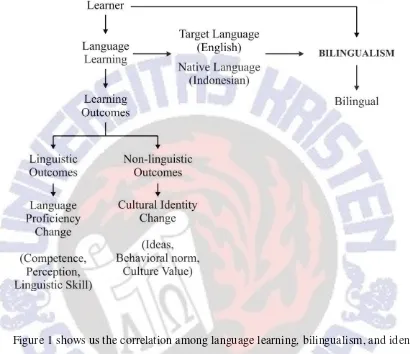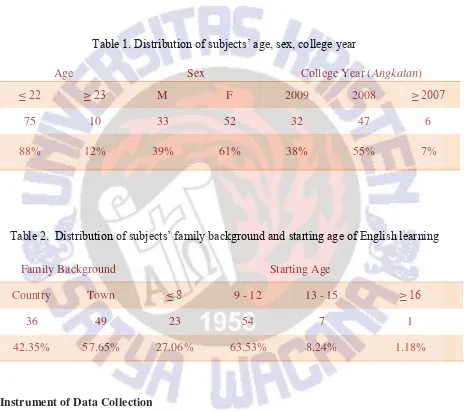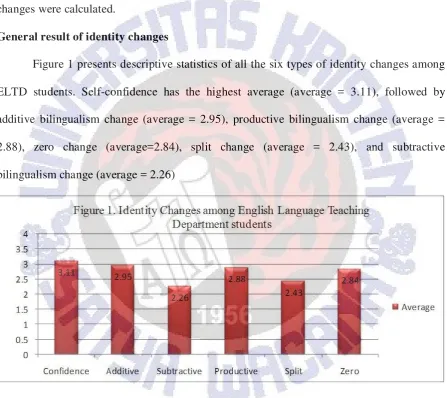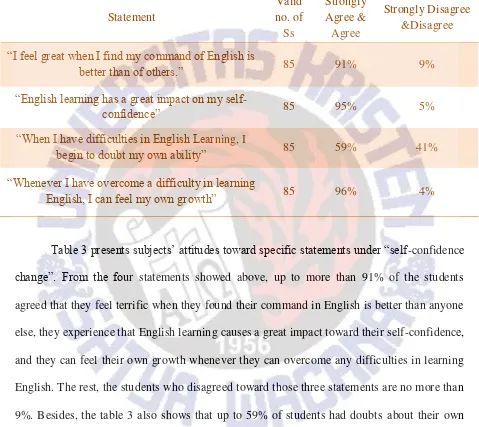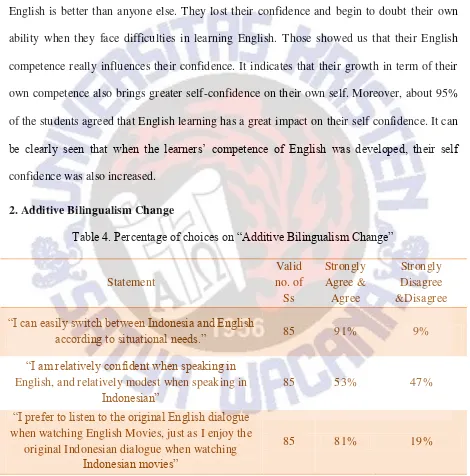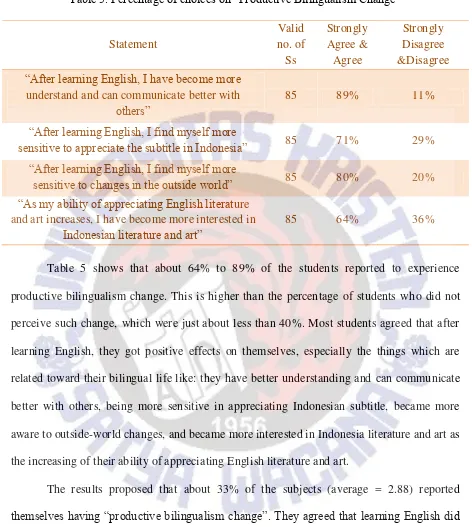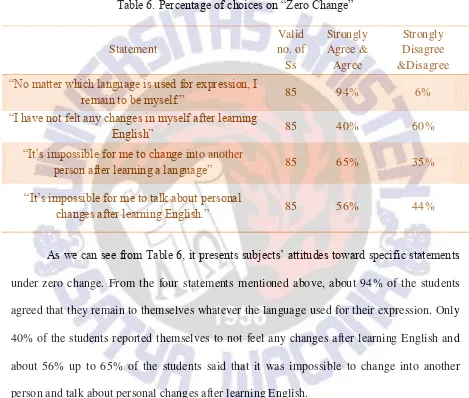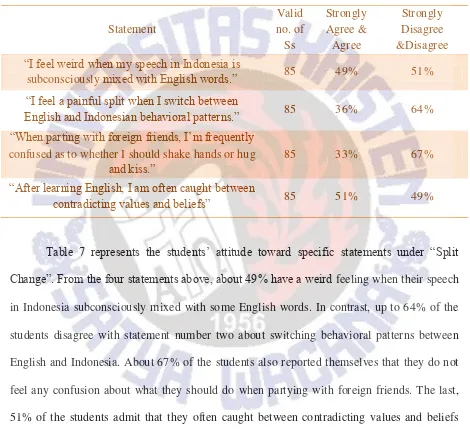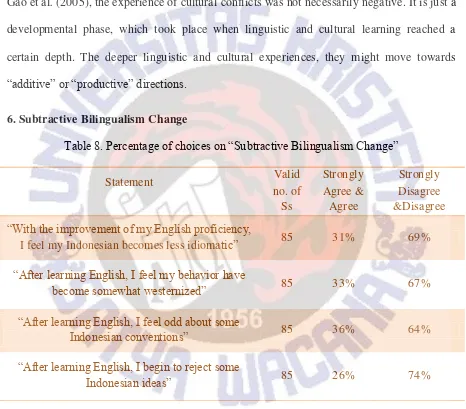ENGLISH LANGUAGE TEACHING DEPARTMENT
STUDENTS’ IDENTITY CHANGES ASSOCIATED WITH ENGLISH
LANGUAGE LEARNING
THESIS
Submitted in Partial Fulfillment of the Requirements for the Degree of
Sarjana Pendidikan
Lourentius Feby Haryanto 112008032
ENGLISH LANGUAGE TEACHING DEPARTMENT FACULTY OF LANGUAGE AND LITERATURE
SATYA WACANA CHRISTIAN UNIVERSITY SALATIGA
i
ENGLISH LANGUAGE TEACHING DEPARTMENT
STUDENTS’ IDENTITY CHANGES ASSOCIATED WITH ENGLISH
LANGUAGE LEARNING
THESIS
Submitted in Partial Fulfillment of the Requirements for the Degree of
Sarjana Pendidikan
Lourentius Feby Haryanto 112008032
ENGLISH LANGUAGE TEACHING DEPARTMENT FACULTY OF LANGUAGE AND LITERATURE
SATYA WACANA CHRISTIAN UNIVERSITY SALATIGA
ii
ENGLISH LANGUAGE TEACHING DEPARTMENT STUDENTS’
IDENTITY CHANGES ASSOCIATED WITH ENGLISH LANGUAGE
LEARNING
THESIS
Submitted in Partial Fulfillment of the Requirements for the Degree of
Sarjana Pendidikan
iii
PUBLICATION AGREEMENT DECLARATION
As a number of the (SWCU) Satya Wacana Christian University academic community, I verify that:
Name : Lourentius Feby Haryanto
Student ID Number : 112008032
Study Program : English Department
Faculty : Faculty of Language and Literature Kind of Work : Undergraduate Thesis
In developing my knowledge, I agree to provide SWCU with a non-exclusive royalty free right for my intellectual property and the contents there in entitled:
English Language Teaching Department student’s identity changes associated with English Language Learning
along with any pertinent equipment.
With this non-exclusive royalty free right, SWCU maintains the right to copy, reproduce, print, publish, post, display, incorporate, store in or scan into a retrieval system or database, transmit, broadcast, barter or sell my intellectual property, in whole or in part without express written permission, as long as my name is still included as the writer.
iv
COPYRIGHT STATEMENT
This thesis contains no such material as has been submitted for examination in any course or accepted for the fulfillment of any degree or diploma in any university. To the best of my knowledge and my belief, this contains no material previously published or written by any other person accept where due reference is made in the text.
Copyright@ 2013. Lourentius Feby Haryanto and Anne I. Timotius, M.Ed
All right reserved. No part of this thesis may be reproduced by any means without the permission of at least one of the copyright owners or the English Department, Faculty of Language and Literature, Satya Wacana Christian University, Salatiga.
1
ENGLISH LANGUAGE TEACHING DEPARTMENT STUDENTS’
IDENTITY CHANGES ASSOCIATED WITH ENGLISH LANGUAGE
LEARNING
Lourentius Feby Haryanto 112008032
Abstract
English is regarded as an international language and because of that, most Indonesian students must learn English as foreign language (EFL). Considerably, learning any languages, including English is not only a matter of the language itself. It is also related to its
culture‘s behavioral norms, and culture values that commonly determine self-identity of its
users. This quantitative study investigated English Language Teaching Department students‘ identity changes associated with English language learning. The subjects were 85 English Language Teaching Department students of Satya Wacana Christian University, obtained from a purposive sampling. The instrument of the research was a closed-ended questionnaire about six categories of self-identity changes based on a study conducted by Gao Yihong, Cheng Ying, ZhaoYuan, and Zhou Yan (2005). According to literature of bilinguals‘ identities, those six categories of identity changes are: self-confidence, subtractive bilingualism change, additive bilingualism change, productive bilingualism change, identity split change, and the last one is zero change. The results showed that in the English Language Teaching Department of Satya Wacana Christian University EFL context, the most prominent identity changes type occurred on the learners was self-confidence.
Keywords: Identity changes, English language learning.
Introduction
Language is not only considered as an instrument for communication. It is also related to a set of behavioral norms and cultural value of its users which construct someone‘s identity (Gao et al., 2005). Identity is rather a ‗catch-all‘ term used to represent almost
2
learning and cultural groups that they belong to, as well as their values. This is in line like what Gao, Cheng, Zhao, and Zhou (2005) statement which say that learning a new language may bring identity changes toward its users including competence, language style, or their value system. Indonesian people have Indonesian as their native language. Besides, they also learn English as a target language in addition. Such condition raises a question. What will happen when their native language with its native culture meets up with a condition when they have to learn target language and its culture? More or less, such condition brings some particular impacts toward their identity related to the goals, values, and beliefs that an individual adopts and holds (Schwartz et al., 2006).
On their classical social psychological model of language learning as cited in Dai (2009-2010), Gardner and MacIntyre (1993) proposed a theory that there are two sets of learning outcomes which can be formed by language learning. The first one is linguistic outcome which is associated to changes in an individual's competence, knowledge, and skill in some aspect of the language (vocabulary, grammar, reading, writing, speaking, pronunciation, or listening comprehension). The second one is non-linguistic outcomes, which refer to various affective characteristics such as attitudes towards the other language group, attitudes towards TL learning, intentions to use the language in the future, and anxiety about learning or using the language (Gardner et al., 2005, as cited in Viskari, 2005). So, nonlinguistic outcomes refer to attitudes and values that develop from the TL learning experience (Gardner, 1985, as cited in Viskari, 2005). Those outcomes are related to Gao et al.‘s (2007) acknowledgement about how learners perceive themselves in terms of linguistic
3
changes do not only deal with cultural identities, but also the language proficiency of the learner itself.
Figure 1. The correlation among language learning, bilingualism, and identity changes
4
(2009-2010), classical social psychological model of language learning, when the learners learn about language, they may undergo non-linguistic outcomes where their cultural identity may experience changes. During the learning process, the learners do not only learn about the linguistic things about the target language. They also learn about its ideas, behavioral norm, and cultural value which will construct their identity.
According to Gottardo & Grant (2008), multilingualism is an ability to speak more than two languages with approximately equal facility, while the definition of bilingualism is more complex and is influenced by multiple factors such as the age of acquisition of the second language, continued exposure to the first language (L1), relative skill in each language, and the circumstances under which each language is learned. Popular definitions of bilingualism conceptualize language knowledge as being a binary category—whether one is classified as having acquired two languages or not (Brutt-Griffler & Varghese, 2004, as cited in Gottardo & Grant, 2008). In its simplest form, bilingualism is defined as ―knowing‖ two
languages. According to Valdez and Figueora (1994) as cited in May, Hill & Tiakiwai (2004), classifications of bilinguals in the research usually acknowledge the complexity of defining bilingualism. As if often believed, bilingualism is defined as psychological and social states of individuals or groups of people that result from interactions via language in which two or more linguistic codes (including dialects) are used for communication (Hutler and Hakuta, 2004).
In his paper, Roberts (1995) acknowledged a statement proposed by Lambert (1975), that there are two types of bilingualism that affect a learner‘s identity. The first one is
―subtractive‖ bilingualism. This type of bilingualism occurs when the native language and
native cultural identity are replaced by the target language and target cultural identity. Whereas, the second one is ―additive‖ bilingualism which the learner‘s native language and
5
acquired in addition. In light of humanistic psychology, Fromm‘s (1948) ―productive
orientation‖, Maslow‘s (1957) theory of basic human needs and its expansion (Xu, 1988,
1999), Gao (2001, 2002) proposed a concept of ―productive bilingualism‖ as alternative from
those subtractive and additive bilingualism. With productive bilingualism, the command of the target language and the native language positively reinforce each other; deeper understanding and appreciation of the target culture goes hand in hand with deeper understanding and appreciation of the native culture. Besides, Fromm (1948) as cited in Gao, Cheng, Zhao, and Zhou (2005) also proposed that those kinds of language learners have a ―productive orientation‖ in language learning; they are motivated by self-actualization needs
(Maslow, 1957, as cited in Francis, 1992). As an ideal type of bilingualism, productive bilingualism is commonly symbolized as ―1 + 1> 2‖ which means the two linguistic and
community identities reinforce each other. Deeper understanding, appreciation, and empathy with one community go hand in hand with that of the other (Gao et al., 2005). On the other hand, subtractive bilingualism and additive bilingualism are symbolized as ―1 – 1 = 1‖ and ―1
+1 =1‖ respectively. ―1 – 1 = 1‖ illustrates that one identity associated with a certain
linguistic variety is replaced by another identity associated with a different linguistic variety whereas ―1+1=1‖ means Two (or more) identities associated with different linguistic varieties co-exist in one‘s linguistic and identity repertoire, and have respective roles to play
in different communicative situations or for different purposes (Gao et al., 2005). The empirical basis of productive bilingualism consisted of interviews with some recognized
―best target language learners,‖ mostly professors, researchers and translators and up until
now, there are still few researches that talk about such bilingualism or self-identity changes that have been conducted among college learners.
6
English language learning of English Languag Teachng Department (ELTD) students of Satya Wacana Christian University Salatiga. As we know that all ELTD students are bilingual which means they obtain the knowledge and use of more than one language (Hutler and Hakuta, 2004) and in this context, they are able to speak Indonesian and English. I was interested whether they undergo identity changes after acquiring English or not. Hence, if bilingualism surely affects their self identity, I was wondering what kind of identity changes they have undergone after learning English. The present study aimed at exploring the
learners‘ identity changes associated with English learning. Besides, through this research we
are able to know whether the identity changes they experienced included to positive outcome or the negative one toward their identity. It is a phenomenon of learning English that almost happens in every country. On the other hand, it is quite distinctive since this topic also can be linked to many things such as culture value, behavior norms, and also about the psychology of the learners.
Theoretical Framework
This study aimed to analyze:
What types of identity changes are caused by English Language Learning experienced by English Language Teaching Department students of Satya Wacana Christian University?
As stated previously at the very beginning, the study used the six categories of self-identity changes based on Gao Yihong, Cheng Ying, Zhao Yuan, and Zhou Yan (2005).
7
changes after learning a new language. For example, after learning English, a learner feels that he/she becomes more confident or maybe they feel their own growth after they can successfully overcome difficulties in English learning.
The second category is additive bilingualism change where the learner‘s native language and native cultural identity is maintained while the target language and target cultural identity is acquired in addition (Lambert, 1975, as cited in Chunyan, 2005). The study designed by Cummins (1981) stated in Roberts (1995) shows that additive type is related to positive effects whereas the subtractive approaches to negative effects on the learners. Such bilingualism occurs usually when two languages complement one other (or the speaker is a balanced / competent user both). The co-existence of two sets of languages, behavioral patterns, and values, each specified for particular contexts (Boonchum, 2009).
The third category of self-identity changes is subtractive bilingualism change. This category is the inverse of the previous one. If additive change can maintain between native and culture language and target native and culture so that there is no one side is ―falling‖; in
subtractive change, the native language and native cultural identity are replaced by the target language and target cultural identity. According to Lambert (1975) as cited in Roberts (1995), subtractive bilingualism characterizes the situation in which students lose their first language in the process of acquiring their second language. Having such bilinguali sm refers to the negative affective and cognitive effects of bilingualism. So, the ―falling‖ of the
learner‘s native language and culture are caused by the target language and its culture.
Subtractive bilingualism is a common phenomenon in learning a target language or it is like the ―side-effect‖ of learning a new language.
8
bilingualism‖, the command of the target language and that of the native language positively
reinforce each other; deeper understanding and appreciation of the native culture; learners‘ cognitive affective, and behavioral competence are enhanced as a whole. This category can be assumed as the positive change because both languages are supporting each other. No one side really raises and no one side falls. Compared to additive change, productive change seems to be better because in additive change, the target language and culture are just addition but there is no absolute impact toward the learners‘ native culture and language. On
the other hand, in productive bilingualism change, the target language and culture have a positive influence toward the learners‘ native language and culture.
The fifth category is identity split change. This category is related to the struggle between the languages and cultures gives rise to identity conflict (Gao et al., 2005). Such conflict commonly happen since the target language and culture are different compared to the native language and culture (Gao et al., 2005). This kind of change can be clearly illustrated
through participants‘ statements of Gao et al. (2005) study about self identity changes and
English learning among Chinese undergraduates. For example, ―when parting with foreign
friends, I‘m frequently confused as two whether I should shake hand or hug and kiss‖ or ―I
feel a painful split when I switch between English and Chinese behavioral patterns‖ (Gao et
al., 2005).
The last change is a condition where there is no self-identity changes at all called zero change. Sometimes such change also acquired by some learners when they think no matter what language is used for expression; they remain to be their own selves (Gao et al., 2005).
According to Gao et al. (2005) above-mentioned categories, ―zero change‖ was a
category used for comparison. On the other hand, ―self-confidence change‖ was the
9
cognitive dissonance, learners experiencing split change might develop other types of identity changes afterward.
The Study
Context of the study
The setting of the study was the English Language Teaching Department of the Faculty of Language and Literature in Satya Wacana Christian University. It is located in a small town of Salatiga, Central Java, Indonesia. The reason why I chose this faculty was because first, I was studying there so it would be easier for me to conduct a research in my own faculty. The second, the focus of my study was on the bilingualism among English Language Teaching Department students of Satya Wacana Christian University who are prepared to be English teacher in the future. Since they have to be English teacher, they are ‗forced‘ to be bilingual (in English). The reason for selecting that focus was because I was
wondering about what happen to them after acquiring English as their target language.
Participant
The participants were 85 ELTD students of Satya Wacana Christian University who are in the middle year of study or above. The study used purposive sampling strategies and the student participants had been selected because of the following reasons:
The English Language Teaching Department students of Satya Wacana Christian
University are the ones who acquire bilingualism through English language learning longer and more intense as their routine rather than another students from different major and faculty.
The participants were taken from third year students or above because they must
10
The longer the participants studying English as their target language, the clearer the effect of bilingualism on their self identity can be seen.
There are also statistics data of the participants which is related to the study below, including the distribution of subjects‘ age, sex, college year and subjects‘ family background
and starting age of English learning.
Table 1. Distribution of subjects‘ age, sex, college year
Age Sex College Year (Angkatan)
≤ 22 ≥ 23 M F 2009 2008 ≥ 2007
75 10 33 52 32 47 6
88% 12% 39% 61% 38% 55% 7%
Table 2. Distribution of subjects‘ family background and starting age of English learning
Family Background Starting Age
Country Town ≤ 8 9 - 12 13 - 15 ≥ 16
36 49 23 54 7 1
42.35% 57.65% 27.06% 63.53% 8.24% 1.18%
Instrument of Data Collection
In attempting to answer the research question, the data was collected through questionnaire. The reason why I used questionnaire was because my research was a survey and questionnaire is one of the effective tools in generating survey research which commonly contain information such as the percentage of respondents‘ opinion / attitude (Borg and Gall,
11
Adams, Anne and Cox, Anna L. (2008), questionnaires can be an invaluable tool when usability data is needed from large numbers. It can be both cost-effective and easier to analyze than other methods. The questionnaires were spread randomly to 100 Engli sh Language Teaching Department students. At the end, the questionnaires which returned were only 85. The questionnaire consisted of 23 statements on self-identity changes types adopted from the questionnaire made by Gao Yihong, Cheng Ying, Zhao Yuan, and Zhou Yan (2005) toward self-identity changes (See Appendix A for the detail information of the questionnaire). It took no more than 5 minutes to fill in. It was measured by a Likert scale (1=strongly disagree; 2=disagree; 3=agree; and 4=strongly agree).
Procedures of data collection
Before distributing the questionnaire, 5 participants were randomly chosen in order to check the clarity of the questionnaire. After that, the researcher spread the questionnaires randomly to English Language Teaching Department students who have already taken Cross Culture Understanding course. The participants were asked to answer the questionnaire and return it as soon as they complete it. After all the questionnaires had been collected, the finding of the questionnaire was ready to be analyzed
Data Analysis
12
Discussion
The data was statistically analyzed to answer the research question. To establish the type of identity changes that occur among ELTD students, the discussion was divided into two parts: general result of identity changes and analysis of each type of identity changes. The number and percentage of overall prominent identity changes and each type of identity changes were calculated.
General result of identity changes
Figure 1 presents descriptive statistics of all the six types of identity changes among ELTD students. Self-confidence has the highest average (average = 3.11), followed by additive bilingualism change (average = 2.95), productive bilingualism change (average = 2.88), zero change (average=2.84), split change (average = 2.43), and subtractive bilingualism change (average = 2.26)
13
In the following section, the result of each identity changes type will be discussed more specifically
1. Self-Confidence
Table 3. Percentage of choices on ―Self-Confidence Change‖
Statement
―I feel great when I find my command of English is
better than of others.‖ 85 91% 9%
―English learning has a great impact on my self
-confidence‖ 85 95% 5%
―When I have difficulties in English Learning, I
begin to doubt my own ability‖ 85 59% 41%
―Whenever I have overcome a difficulty in learning
English, I can feel my own growth‖ 85 96% 4%
Table 3 presents subjects‘ attitudes toward specific statements under ―self-confidence
change‖. From the four statements showed above, up to more than 91% of the students
agreed that they feel terrific when they found their command in English is better than anyone else, they experience that English learning causes a great impact toward their self-confidence, and they can feel their own growth whenever they can overcome any difficulties in learning English. The rest, the students who disagreed toward those three statements are no more than 9%. Besides, the table 3 also shows that up to 59% of students had doubts about their own competence due to difficulties in English learning.
Gao et al. (2005) stated that:
The prominence of self-confidence change as a learning outcome might reflect characteristics of
Chinese EFL context, as distinguished from ESL context: limited exposure to the target culture,
yet very high value attached to the target language. In such a context, the impact of language
learning on learners‘ perception of their competence was greater than on their cultural identities.
14
In line with that statement, the result of this study showed that self-confidence change type achieved the highest average. It might reflect the characteristics of English Language Teaching Department students of Satya Wacana Christian University. The impact of English language learning on learners‘ perception of competence was greater than their cultural identities. From the data gathered, they agreed that they feel great when their command in English is better than anyone else. They lost their confidence and begin to doubt their own ability when they face difficulties in learning English. Those showed us that their English competence really influences their confidence. It indicates that their growth in term of their own competence also brings greater self-confidence on their own self. Moreover, about 95% of the students agreed that English learning has a great impact on their self confidence. It can be clearly seen that when the learners‘ competence of English was developed, their self
confidence was also increased.
2. Additive Bilingualism Change
Table 4. Percentage of choices on ―Additive Bilingualism Change‖
Statement
―I can easily switch between Indonesia and English
according to situational needs.‖ 85 91% 9%
―I am relatively confident when speaking in English, and relatively modest when speaking in
Indonesian‖
85 53% 47%
―I prefer to listen to the original English dialogue when watching English Movies, just as I enjoy the
original Indonesian dialogue when watching Indonesian movies‖
85 81% 19%
Table 4 shows the subjects‘ attitude toward additive bilingualism change. We can see
15
according to the situational needs. About 47% of students did not have good confidence when speaking English and being modest when they use Indonesian. It can also be seen that although the students‘ major is English, 81% of the students still enjoy using Indonesian
subtitle when watching Indonesian movies.
16 3. Productive Bilingualism Change
Table 5. Percentage of choices on ―Productive Bilingualism Change‖
Statement ―After learning English, I have become more
understand and can communicate better with others‖
85 89% 11%
―After learning English, I find myself more
sensitive to appreciate the subtitle in Indonesia‖ 85 71% 29%
―After learning English, I find myself more
sensitive to changes in the outside world‖ 85 80% 20%
―As my ability of appreciating English literature and art increases, I have become more interested in
Indonesian literature and art‖
85 64% 36%
Table 5 shows that about 64% to 89% of the students reported to experience productive bilingualism change. This is higher than the percentage of students who did not perceive such change, which were just about less than 40%. Most students agreed that after learning English, they got positive effects on themselves, especially the things which are related toward their bilingual life like: they have better understanding and can communicate better with others, being more sensitive in appreciating Indonesian subtitle, became more aware to outside-world changes, and became more interested in Indonesia literature and art as the increasing of their ability of appreciating English literature and art.
The results proposed that about 33% of the subjects (average = 2.88) reported themselves having ―productive bilingualism change‖. They agreed that learning English did
not negatively affect their native language and culture. Instead, English learning had positively reinforced the students‘ understanding, attitude, and appreciation toward their
Indonesia and Indonesian culture. It means that ELTD students had Fromm‘s (1948)
―productive orientation‖ in language learning (Gao, 2005). Both target and native language
17
native culture (Gao, 2001, as cited in Gao et al., 2005). According to Maslow (1957), as cited in Gao et al. (2005), these 33% of subjects have undergone the ideal type of bilingualism because their two linguistics and community identities can reinforce each other and positively goes hand in hand.
4. Zero Change
Table 6. Percentage of choices on ―Zero Change‖
Statement ―No matter which language is used for expression, I
remain to be myself.‖ 85 94% 6%
―I have not felt any changes in myself after learning
English‖ 85 40% 60%
―It‘s impossible for me to change into another
person after learning a language‖ 85 65% 35%
―It‘s impossible for me to talk about personal
changes after learning English.‖ 85 56% 44%
As we can see from Table 6, it presents subjects‘ attitudes toward specific statements
under zero change. From the four statements mentioned above, about 94% of the students agreed that they remain to themselves whatever the language used for their expression. Only 40% of the students reported themselves to not feel any changes after learning English and about 56% up to 65% of the students said that it was impossible to change into another person and talk about personal changes after learning English.
According to Gao et al. (2005), for those who reported zero change on themselves experienced what is called by ―absence of identity changes‖. It is a condition where language learning only has impact toward the users‘ language proficiency, not their cultural identity. In
18
not their identity. In conclusion, these 40% up to 94% students was reported to not have identity changes caused by English language learning. Their linguistic competence is increasing, but they remain to be themselves.
5. Split Change
Table 7. Percentage of choices on ―Split Change‖
Statement ―I feel weird when my speech in Indonesia is
subconsciously mixed with English words.‖ 85 49% 51%
―I feel a painful split when I switch between
English and Indonesian behavioral patterns.‖ 85 36% 64%
―When parting with foreign friends, I‘m frequently confused as to whether I should shake hands or hug
and kiss.‖
85 33% 67%
―After learning English, I am often caught between
contradicting values and beliefs‖ 85 51% 49%
Table 7 represents the students‘ attitude toward specific statements under ―Split
Change‖. From the four statements above, about 49% have a weird feeling when their speech
in Indonesia subconsciously mixed with some English words. In contrast, up to 64% of the
students disagree with statement number two about switching behavioral patterns between
English and Indonesia. About 67% of the students also reported themselves that they do not
feel any confusion about what they should do when partying with foreign friends. The last,
51% of the students admit that they often caught between contradicting values and beliefs
after learning English.
In split change, cultural conflict did exist. The struggle between the languages and
cultures gives rise to identity conflict (Gao et al., 2005). Those four statements are
19
Table 7, a small portion of students (average = 2.43) experienced the cultural conflict resulting from English learning. Take split change as an example: 33% to 51% of the
students felt conflicts at linguistic, behavioral, and belief levels. Since the gap percentages
between those who agree and disagree toward those four statements were not very different,
it indicates that this type of change were not common among ELTD students. According to
Gao et al. (2005), the experience of cultural conflicts was not necessarily negative. It is just a
developmental phase, which took place when linguistic and cultural learning reached a
certain depth. The deeper linguistic and cultural experiences, they might move towards
―additive‖ or ―productive‖ directions.
6. Subtractive Bilingualism Change
Table 8. Percentage of choices on ―Subtractive Bilingualism Change‖
Statement Valid
―With the improvement of my English proficiency,
I feel my Indonesian becomes less idiomatic‖ 85 31% 69%
―After learning English, I feel my behavior have
become somewhat westernized‖ 85 33% 67%
―After learning English, I feel odd about some
Indonesian conventions‖ 85 36% 64%
―After learning English, I begin to reject some
Indonesian ideas‖ 85 26% 74%
As shown in Table 8, the percentages of students‘ attitude toward specific statements
under ―Subtractive Bilingualism Change‖ mostly go to strongly disagree and disagree. 64%
to 74% of the students disagreed with statements which indicate the change on their both
language and culture after learning English. On the other hand, about 26% up to 36% of the
20
students begin to reject some Indonesian ideas after learning English. About 31% up to 33%
of the students feel that their Indonesian becomes less idiomatic and their behavior have
become westernized. The last, about 36% of the students feel odd about some Indonesian
conventions after learning English for years.
Subtractive bilingualism change is the least change occur among ELTD students
(average = 2.26). It suggests that this type of identity change were not common among ELTD
student. Since subtractive bilingualism typically has a negative effect on the learners
(Roberts, 1995) and it is the least type occurs, it becomes a good sign for ELTD students for
not having negative attitude and undergoes such negative impact of learning English.
Through this result, it is glad to know that English Language Teaching Department students
can keep their native language, culture, and value well although they have acquired high
proficiency of English.
Conclusion
The study aimed to discover English Language Teaching Department students‘
identity changes associated with English learning using six types of identity changes from
Gao et al. (2005). The most obvious finding to emerge from this study was that there were
six type of identity changes occur after acquiring English learning. Those are self-confidence, subtractive bilingualism change, additive bilingualism change, productive bilingualism change, identity split change, and the last one is zero change.
Returning to the research question posed at the beginning of the study, it is now clear that this study had discovered that the most prominent identity change type occur among
English Language Teaching Department students was ―self-confidence‖ (average = 3.11).
21
perception of competence is greater instead of on their cultural identities like what Gao et al. (2005) have discovered in their study entitled ―self-identity changes and English learning
among Chinese undergraduates‖ (2005). The gathered data showed that the learners‘ English
competence really influences their confidence like they will feel great when they find their command in English is better than anyone else and they begin to doubt their own ability when they cannot overcome their difficulties in English language learning. Those indicate that their growth in term of their own competence also brings greater self-confidence on
themselves. So, it can be clearly seen that when the learners‘ competence of English was
developed, their self confidence was also increased.
More specific analysis of each type of identity changes was also reported. Through the results, it was also discovered that some English Department students also undergone some changes on their cultural identities. Cultural identity changes have become a part of their self development of learning English because language and culture are two things which are related to each other and it cannot be apart.
Regarding to the analysis of the findings, this study suggests two noteworthy implications. First, in order to enhance positive identity changes of the learners, the English Language Teaching Department lecturers should make efforts in fostering English Language Teaching Department students‘ learning motivation. It can be done not only through
enhancing the learners‘ linguistic knowledge and skill, but it can also be done by giving good
motivation in learning English. Some motivations of immediate nature, such as test scores, learning situation and going abroad seemed to have ―minus‖ effect on cultural self-identity,
i.e., subtractive and split changes (Gao et al., 2007). Second, since productive bilingualism exists among English Language Teaching Department of Satya Wacana Christian University,
22
language and culture as well as enhancing their understanding and appreciation of the native language and culture. A good integration of the two will guide to productive changes.
Naturally, this study still has some limitations. This study uses Likert-scale questionnaire as the data collection instruments. This kind of questionnaire seemed to be vague for the participants. In line with Hatch and Brown (1995), they also agreed that participant‘ responses toward Likert-scale questionnaire can change according to the context.
Here, the questionnaire has some unclear intention in certain points which a bit difficult for the participants to understand. In order to bring more clarity for the questionnaire, having bigger number of piloting participants may be needed. Other limitation also occurs in the conceptual understanding of zero change type. It is said that the ones who reported their self having zero change undergo an absence of identity changes and remain to themselves. It is almost impossible if the learners really do not have any changes after all. Even a trivial change is being a part of self development. It is really suggested for the future work to discover deeper understanding about zero change.
Acknowledgement
23
24
References
Adams, Anne and Cox, Anna L. (2008). Questionnaires, in-depth interviews and focus groups. In: Cairns, Paul and Cox, Anna L. eds. Research Methods for Human Computer Interaction. Cambridge, UK: Cambridge University Press, pp. 17–34. Retrieved January 4th, 2013 from http://oro.open.ac.uk/11909/1/
Boonchum, P. (2009). A Study of Self-identity Changes and Correlation of Influential Factors of Thai students Studying English. Educational Research dan Review. 4(11). 535-548. Retrieved August 15th, 2012 from
http://www.academicjournals.org/err.
Borg, W. R. & Gall M. D. (1979). Educational Research (3rd ed). New York : Longman Inc.
Butler, Y.G. & Hakuta, K. Y. (2004-2006). Bilingualism and Second Language Acquisition. In Bhatia, T.J. & Ritchie, W.C. (Eds), The Handbook of Bilingualism (pp.114-144). : Oxford : Blackwell Publishing Ltd. Retrieved August 15th, 2012 from
http://www.ehu.es/HEB/Mikel/Adam%26Mikel_Master2011_12/Lecture%208%2
0biblio/The_Handbook_of_Bilingualism_chapter5.pdf
Chunyan, M. (2005). Additive Bilingualism or ‘Straight-for-English’? The linguistic and cultural impact of different approaches to the teaching of English on children in
two Chinese schools. Unpublished master‘s thesis, University of the Western
Cape, South Africa Retrieved January 4th, 2013 from
http://etd.uwc.ac.za/usrfiles/modules/etd/docs/etd_init_6802_1174558167.pdf
Dai, M. (2009-2010). The Relationships of Language Learning Motivation, Language Proficiency and Self Identity Changes in EFL Learning Context. National Taiwan Normal University. Retrieved August 13th, 2012 from
http://www.ntnu.edu.tw/acad/rep/r97/a4/a407-1.pdf
Gao, Y., Zhao,Y., Cheng, Ying & Zhou, Y. (2005). Self-Identity Changes and English Learning among Chinese Undergraduates. World Englishes. 24(1), 39-51. Retrieved August 7th, 2012 from http://cdn.transtutors.
25
Gao, Y., Zhao,Y., Cheng, Ying & Zhou, Y. (2007). Relationship between English Learning Motivation Types and Self-Identity Changes among Chinese Students. TESOL QUARTERLY, 41(1), 133-155. Retrieved August 7th, 2012 from
http://www.readingmatrix.com/conference/pp/proceedings/yihong.pdf
Gottardo, A. & Grant, A. (2008). Defining Bilingualism. CANADIAN LANGUAGE &
LITERACY RESEARCH NETWORK. Retrieved from
http://www.literacyencyclopedia.ca
Hatch, E. & Brown, C. (1995). Vocabulary, Semantic, and Language Education. Cambridge : Cambridge University Press.
Heylighen, F. (1992). A Cognitive-Systemic Reconstruction of Maslow‘s Theory of Self -Actualization. Behavioural Science, 37. Retrieved January 4th, 2013 from
http://pespmc1.vub.ac.be/Papers/Maslow.pdf
May, S., Hill, R. & Tiakiwai, S. (2004). Bilingual/Immersion Education: Indicators of Good Practice (Final Reports to the Ministry of Education). New Zealand: Wilf
Malcom Institute of Educational Research School of Education, University of Waikato. Retrieved January 4th, 2013 from
http://jamaica.kdid.org/sites/jamaica/files/gcontentadmin/files/bilingual-education%20-%20indicators%20of%20good%20practice.pdf
Otaola, J. R. (2008). Supporting Additive Bilingualism of Online English as a Second Language (ESL) Students through Instructional Design. Unpublished doctoral dissertation, Capella University, United States. Retrieved August 13th, 2012 from
http://gradworks.umi.com/3311405.pdf
Roberts, C.A. (1995). Bilingual Education Program Models: A Framework For
Understanding. The Bilingual Research Journal. 19(3-4). 369-378. Retrieved August 14th, 2012 from
http://www.ncela.gwu.edu/files/rcd/BE021127/Bilingual_Education_Program.pd
f
26
Applied Recommendation. Human Development. 49. 1-30. Retrieved August 14th, 2012 from http://sethschwartz.info/pdfs/Acculturation_and_Identity.pdf
Viskari, K. (2005). Target language Learning Disabilities: Theoritical and Practical Tools for English Teachers in Finnish Upper Secondary Schools. Unpublished master‘s
thesis, University of Jyvaskyla, Finland. Retrieved September 10th, 2012 from
27
Appendix A
QUESTIONNAIRE
Dear friends,
I am interested in researching identity changes caused by English Language Learning. Your participation in this survey will help me to complete my thesis. Please kindly spare a few minutes of your time to fill out this questionnaire. Your responses to this questionnaire will be treated with utmost confidence. Thank you for your cooperation.
Student Number :
Age :
Sex : F / M
Starting Age of English Learning :
Family Background : Country / Town
Email :
28
There are 23 statements related to your condition after learning English below. Choose the most appropriate one for each statement and give check mark (√) for your best answer.
―Self-confidence change‖
2. ―English learning has a great impact on
my self-confidence‖
3. ―When I have difficulties in English
Learning, I begin to doubt my own ability‖
4. ―Whenever I have overcome a difficulty
in learning English, I can feel my own growth‖
1. ―I can easily switch between Indonesian
and English according to situational needs.‖
2. ―I am relatively confident when
speaking in English, and relatively modest when speaking in Indonesian‖
3. ―I prefer to listen to the original English
29
1. ―With the improvement of my English
proficiency, I feel my Indonesian becomes less natural‖
2. ―After learning English, I feel my
behavior have become somewhat westernized‖
3. ―After learning English, I feel odd about
some Indonesian conventions‖
4. ―After learning English, I begin to reject
some Indonesian ideas‖
1. ―After learning English, I have become
more understand and can communicate better with others‖
2. ―After learning English, I find myself
more sensitive to appreciate the Indonesian subtitle‖
3. ―After learning English, I find myself
more sensitive to the outside world changes‖
4. ―As my ability of appreciating English
30
3. ―When parting with foreign friends, I‘m
frequently confused as to whether I should shake hands or hug and kiss.‖
4. ―After learning English, I am often caught
between contradicting values and beliefs‖
1. ―No matter which language is used for
expression, I remain to be myself.‖
2. ―I have not felt any changes in myself
after learning English‖
3. ―It‘s impossible for me to change into
another person after learning a language‖
4. ―It‘s impossible for me to talk about
personal changes after learning English.‖
31
Appendix B
DESCRIPTIVE STATISTIC FOR ENGLISH DEPARTMENT STUDENTS‘ IDENTITY CHANGES
No NIM
Types of Identity Changes
Self-convidence Additive Subtractive Productive Split Zero
S1 S2 S3 S4 S1 S2 S3 S1 S2 S3 S4 S1 S2 S3 S4 S1 S2 S3 S4 S1 S2 S3 S4
1 112008100 4 4 1 4 4 4 4 1 2 2 3 4 3 3 3 2 2 1 2 4 4 4 4
2 112009004 4 4 3 4 4 3 3 2 2 2 3 3 2 2 2 2 2 2 2 4 2 2 2
3 112007127 3 3 3 3 1 2 2 1 2 2 1 3 3 3 4 3 3 1 3 3 2 3 3
4 112009080 3 3 2 3 3 3 2 3 2 2 2 3 2 2 2 2 2 2 2 4 3 2 2
5 112009055 2 3 2 3 3 3 3 2 2 3 3 3 3 3 3 3 2 2 3 3 2 2 2
6 112009023 3 3 4 4 3 2 3 2 2 2 2 3 3 3 3 3 2 3 3 3 3 3 3
7 112009024 3 3 2 3 3 3 3 3 4 4 3 3 3 3 4 3 3 2 3 3 3 3 3
8 112009016 4 3 2 3 3 1 1 2 2 1 1 3 3 3 4 2 2 2 2 4 3 4 4
9 112009019 4 4 3 4 3 3 3 4 4 4 3 4 3 4 1 3 2 3 3 4 2 3 2
10 112009075 4 3 1 3 3 2 3 2 3 2 1 3 2 3 3 3 2 3 3 3 2 3 2
11 112009040 3 4 2 3 4 4 3 2 3 3 3 3 4 4 2 3 3 4 4 4 2 3 2
12 112009077 3 3 2 3 3 2 3 1 2 2 2 3 3 3 2 3 3 3 2 4 4 2 3
13 112008027 3 3 3 3 3 2 3 2 2 2 2 3 2 2 2 2 2 2 2 4 4 4 3
14 112008109 3 3 2 3 3 2 4 1 4 2 2 3 3 3 2 2 2 1 3 4 2 3 2
15 112009068 3 4 3 3 4 3 3 2 4 4 2 3 3 3 3 2 3 2 3 3 2 2 3
16 112009069 3 3 2 3 3 2 3 2 3 2 2 3 3 3 3 2 2 2 3 3 2 2 2
17 112008115 3 4 3 4 4 2 2 2 3 3 2 4 3 3 2 2 3 1 2 2 1 3 3
18 112008103 3 4 3 4 3 3 4 3 3 2 2 3 2 4 3 2 2 1 2 3 2 2 2
19 112008043 2 2 3 3 4 2 2 1 1 2 3 3 3 3 2 3 3 3 2 4 3 4 2
34
77 112008024 3 2 3 3 3 2 4 3 2 2 2 2 3 3 3 3 2 2 2 3 3 3 3
78 112008061 3 3 2 4 3 2 3 2 3 3 2 3 2 2 3 2 2 2 2 3 2 2 2
79 112008022 3 3 3 3 2 2 3 1 2 3 3 3 3 3 3 4 2 3 3 3 3 4 4
80 112008097 3 3 3 3 3 2 3 2 2 3 3 3 3 3 2 3 2 2 3 3 3 4 3
81 112008007 3 4 3 3 3 3 3 2 2 3 2 3 3 4 2 2 2 3 4 3 4 4 3
82 112008031 3 4 4 4 3 4 3 2 2 3 2 3 3 4 3 2 3 2 4 3 4 4 4
83 112009063 4 4 2 3 3 3 3 3 2 3 1 4 4 4 2 3 2 1 4 4 3 3 3
84 112008018 3 4 4 4 3 3 3 3 1 3 2 4 4 4 3 3 3 2 4 4 4 3 4
85 112009034 3 3 3 3 3 2 3 2 3 2 2 3 3 3 4 4 3 3 3 4 2 3 3
SUBTOTAL 274 279 225 279 271 221 259 190 202 202 173 256 241 249 233 216 199 194 217 294 207 238 226
TOTAL 1057 751 767 979 826 965
AVERAGE
(ITEM) 3.22 3.28 2.65 3.28 3.19 2.60 3.05 2.24 2.38 2.38 2.04 3.01 2.84 2.93 2.74 2.54 2.34 2.28 2.55 3.46 2.44 2.80 2.66
AVERAGE
(TOTAL) 3.11 2.95 2.26 2.88 2.43 2.84
NOTE:
S1 : Statement number one 4 : Strongly Agree
S2 : Statement number two 5 : Agree
